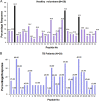The Secreted Protein Rv1860 of Mycobacterium tuberculosis Stimulates Human Polyfunctional CD8+ T Cells
- PMID: 26843486
- PMCID: PMC4820513
- DOI: 10.1128/CVI.00554-15
The Secreted Protein Rv1860 of Mycobacterium tuberculosis Stimulates Human Polyfunctional CD8+ T Cells
Abstract
We previously reported that Rv1860 protein from Mycobacterium tuberculosis stimulated CD4(+)and CD8(+)T cells secreting gamma interferon (IFN-γ) in healthy purified protein derivative (PPD)-positive individuals and protected guinea pigs immunized with a DNA vaccine and a recombinant poxvirus expressing Rv1860 from a challenge with virulent M. tuberculosis We now show Rv1860-specific polyfunctional T (PFT) cell responses in the blood of healthy latently M. tuberculosis-infected individuals dominated by CD8(+) T cells, using a panel of 32 overlapping peptides spanning the length of Rv1860. Multiple subsets of CD8(+) PFT cells were significantly more numerous in healthy latently infected volunteers (HV) than in tuberculosis (TB) patients (PAT). The responses of peripheral blood mononuclear cells (PBMC) from PAT to the peptides of Rv1860 were dominated by tumor necrosis factor alpha (TNF-α) and interleukin-10 (IL-10) secretions, the former coming predominantly from non-T cell sources. Notably, the pattern of the T cell response to Rv1860 was distinctly different from those of the widely studied M. tuberculosis antigens ESAT-6, CFP-10, Ag85A, and Ag85B, which elicited CD4(+) T cell-dominated responses as previously reported in other cohorts. We further identified a peptide spanning amino acids 21 to 39 of the Rv1860 protein with the potential to distinguish latent TB infection from disease due to its ability to stimulate differential cytokine signatures in HV and PAT. We suggest that a TB vaccine carrying these and other CD8(+) T-cell-stimulating antigens has the potential to prevent progression of latent M. tuberculosis infection to TB disease.
Copyright © 2016, American Society for Microbiology. All Rights Reserved.
Figures





References
Publication types
MeSH terms
Substances
LinkOut - more resources
Full Text Sources
Other Literature Sources
Medical
Research Materials
Miscellaneous

